I’ve been reading and listening to various concerns about the San Jose Sharks and one keeps popping up. It’s a concern about current and future salary cap space. I’m not buying it. I’ve looked over the Sharks’ salary cap situation previously and wasn’t concerned. But since concerns are out there, I thought it’s time to take a deeper dive into it. And to share the conclusion right up front, I like the Sharks’ cap position. A lot.
There is no bigger potential free agent than John Tavares of the New York Islanders. If the Sharks can afford Tavares, they can pretty much afford any single asset they’d like, or, alternatively, multiple very good players.
So we’ll take a good look at the most expensive player out there, Tavares, and how San Jose can fit him under the salary cap.
The Sharks’ Big Contracts
Next season’s salary cap is forecasted to fall between $78 million and $82 million. We’ll analyze the low-end of the forecast; things get easier if the cap is set higher.
The Sharks have 16 players with contracts for next season. They combine for a cap hit of $56.1 million.
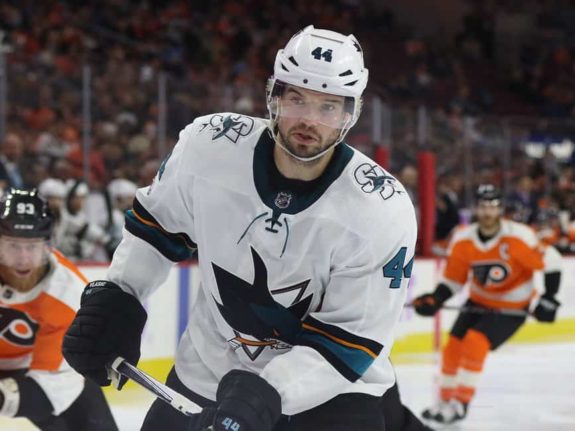
The big contracts belong to Brent Burns, Martin Jones, Marc-Edouard Vlasic, Joe Pavelski and Logan Couture. These use $32.7 million of cap space. Next up is Paul Martin, who takes up $4.85 million in cap space, followed by Mikkel Boedker at $4.0 million. We’ll revisit these two players and their contracts shortly.
Contracts Expiring
San Jose has several contracts which expire at the end of this season.
Backup goalie Aaron Dell is an unrestricted free agent. He isn’t getting the starting job in San Jose, so if one opens up for him, expect him to move on. Alas, starting jobs don’t always open up. Dell’s cap hit is $625,000 –a huge bargain for San Jose. There is no reason for Dell to take a cheap deal, so either the Sharks will pony up a good bit more or someone else will. My guess is someone else will and the Sharks will go shopping for low-cost backup. My take: expect a $1 million or lower figure for the Sharks’ next backup goalie. For now, we’ll allocate $900,000 for the backup goalie.
Tomas Hertl, Dylan DeMelo and Chris Tierney are all restricted free agents. Each will get a raise. I was puzzled by the low-cost, one-year deal for Tierney this past offseason. It seemed an ideal time to sign him to a longer deal at a modest cost. Something like $1.2 million per year over three years. Now it’ll probably cost the Sharks close to $2 million a year to keep him. Tomas Hertl is probably going to cost close to $5 million. Dylan DeMelo probably doesn’t go much above $1 million, however. The Sharks are likely to retain all three players, and I’ll allocate a salary cap hit of $8 million for the trio.
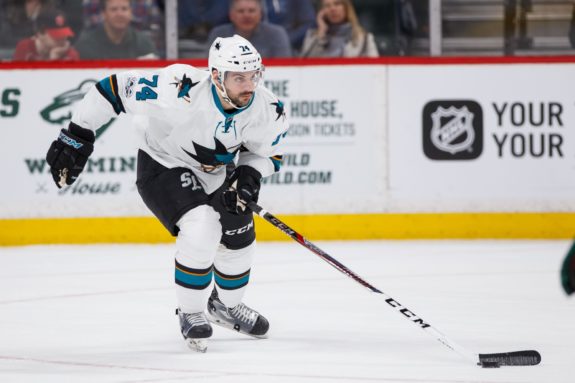
Joel Ward and Jannik Hansen take $5.275 million in cap space and they’re as good as gone. Both are unrestricted free agents. They’ll be replaced by Marcus Sorensen and Danny O’Regan, who will command under $1 million each. We’ll estimate these two combine for a $1.6 million cap cost.
The big swing in this belongs to another unrestricted free agent, Joe Thornton. The best and most important player in team history is on a one-year, $8-million deal. If Tavares comes to San Jose, the question is, how low can San Jose go in paying Thornton? It was reported last season he was willing to leave $1.5 million on the table if it allowed the Sharks to re-sign Patrick Marleau. Thornton put the team ahead of himself. When Marleau left, Thornton took the full offer.
Next season, if the Sharks can add Tavares, Thornton will be asked to take a very large pay cut. But it will be done with the understanding it can be made up the following season. This only works if there are long-term relationships at play and assurances from all levels in the organization, including the owner. The Sharks and Thornton have these relationships.
Thornton can go perhaps as low as $3 million with a handshake agreement that his pay goes up to $7 million for the following season, when more cap space is available. This will pay Thornton a total of $18 million over three seasons between ages 38 and 40. It’ll be a tad less than Patrick Marleau earns in the same timeframe, making Thornton the second-highest paid player in this age group in league history. For now, we’ll be aggressive with Thornton’s pay cut for next season and call it $3.4 million.
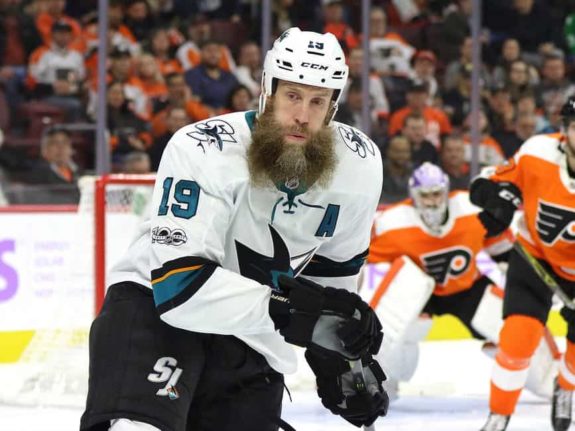
Adding all this up, we get 22 roster spots for $70 million in cap space. This leaves one roster spot and $8 million in cap space. John Tavares isn’t signing for $8 million; we’ll assume he’ll get $10.5 million in his next deal. Which leaves the Sharks with a $2.5 million gap.
The Likely Gap Players
Addressing a gap of $2.5 million is not difficult. The Sharks can move on from certain players. The two most likely are Paul Martin and Mikkel Boedker, who combine for $8.850 million against next year’s cap.
Paul Martin
The first place to look is Paul Martin. It is unlikey the Sharks keep Martin at his price for next season. He’ll either be bought out or traded. If it’s the latter, many expect the Sharks to retain salary.
However, this doesn’t need to be the case. I wouldn’t rule out Martin getting traded to a team near the salary cap floor and the Sharks including a draft pick as compensation for not retaining salary. For example, the Sharks can offer a third-round pick plus Paul Martin for, well, nothing in return. And it’s not like the Sharks need a third-round pick (the notes below explain why).
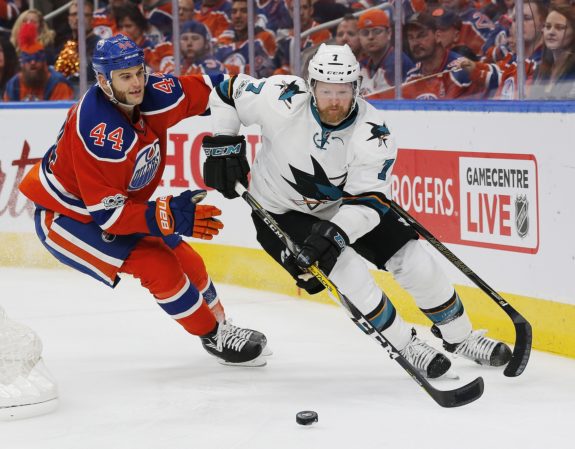
If San Jose can find someone willing to go this route, Martin’s $4.85-million cap hit goes away and is replaced by a $1-million cap hit for a ‘to be determined’ player. In other words, there is a $3.85-million cap-hit reduction, which creates sufficient room to sign Tavares.
I’ll throw out a few examples of teams which might take the Sharks up on this sort of offer. The Buffalo Sabres can pair Martin with Rasmus Ristolainen. The savvy veteran with the young and talented defenseman is often a good combination (Martin has a modified no-trade clause for up to six teams and Buffalo might be one of those).
The Florida Panthers are another potential landing spot and one Martin might be very amenable to. There, Martin can reunite with former Sharks defensive coach Bob Boughner. Martin thrived under Boughner in San Jose. Though cap space is tighter there, Martin is a good fit. The Panthers have a very young, very promising defensive core and, like with Buffalo, having a savvy veteran provides value beyond the on-ice contributions. Martin would certainly be a better fit with Panthers star Aaron Ekblad than his current partner, Keith Yandle.
Mikkel Boedker
Mikkel Boedker is overpaid compared to his contributions. This is a trickier situation than Martin’s. Boedker’s deal runs through the 2019-2020 season and its less likely someone takes on Boedker’s salary for two full seasons. If the Sharks retain the maximum cap hit they can, which is 50 percent, this means they save $2 million in cap space for each of the next two seasons. But a replacement who can produce similarly can cost over $1 million, so the cap space savings will net out at about $1 million.
A Boedker buyout would be distasteful, since the effects would linger for four years. While it would clear $2 million of cap space for each of the next two seasons, the Sharks would still need a replacement, so again, the net cap benefit is only about $1 million. But in this case, there is also a $1 million cap impact for years three and four. The buyout makes less sense than a trade.
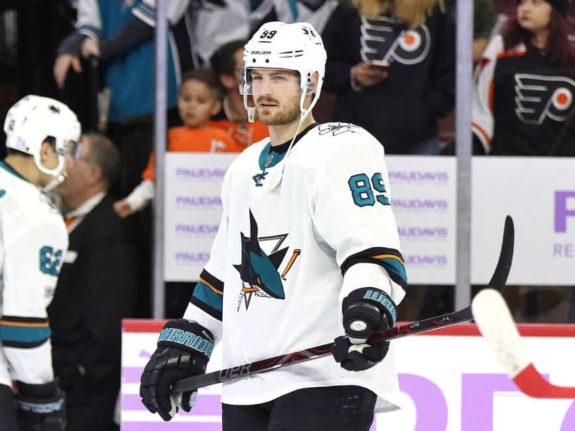
While many Sharks fans disparage Boedker’s value (some more than others), the reality is he’s an NHL-quality player underachieving on a team which doesn’t fit his style of play. His 38 points in 117 games is poor, but he’s gotten next to nothing from the power play (four points). Prior to joining the Sharks he’d gotten about one-third of his points from the power play. And he is a plus-1, suggesting he isn’t a major defensive liability. No doubt there are teams which will use his speed and power-play skills more effectively than San Jose. Boedker is getting heat in San Jose only partly for his play; much of the frustration comes from his contract.
Hidden Advantage
Both Boedker and Martin have a favorable component to their contract. Their salary for the remainder of the contract is less than the cap hit. For teams less worried about the salary cap and more concerned with the actual dollars, the contracts for Martin and Boedker are more reasonable. Boedker’s salary for the next two seasons is $1 million less per year than his salary cap hit. Martin, with only one season left, has a salary $600,000 below his cap hit. While Martin remains expensive, this gives an interested team a bit more room to play with.
For Martin, his veteran presence on a team with young blueliners is part of the equation. For Boedker, it’s a team with a need for speed and power-play scoring. In both cases, teams with salary-cap space and a desire to limit actual salary costs are more likely trade partners. There are at least a few potentially good fits for both players. If either player takes his entire cap hit with him in a deal, the Sharks can fit Tavares under the cap, with even a bit of room to spare. If both players depart and take most of their cap with them, the Sharks have room to sign Tavares – and some wiggle room beyond that.
Other Sharks Approaches
There are other approaches San Jose can use. They can trade other players. The most likely ones are Tomas Hertl, Brenden Dillon or Justin Braun. Each player makes enough money to create the cap space needed for a Tavares signing. Unlike moving on from Martin or Boedker, the Sharks will get something in return for each of these players. Something good. We’re talking first or second-round picks if the timing is right. And since the article is based around John Tavares, I’ll add in a trade scenario involving Tavares. If the Sharks wind up acquiring him via trade, it’s likely one of these players would go to Tavares’ current team in the trade, which would cover the cap issue.

There is some thought the Sharks might move on from Joe Thornton. I doubt this happens. The team and player have a lot of investment in each other. Thornton may want to call it a career, in which case, it’s his choice and an expensive contract will not be needed. But it is hard to imagine Thornton calling it a career if Tavares does come to San Jose. After all, a Stanley Cup is the only thing which has eluded Thornton and a Tavares signing would give the Sharks a very good chance at bringing one home.
Lastly, there is some chatter San Jose might want to move on from goalie Martin Jones, currently mired in a slump. Backup goalie Aaron Dell has been superb and he’ll be much cheaper than Jones. Alas, this is a long shot. Dell may be cheaper, but the NHL is littered with great looking backups who struggled once they got the top job. Jones has proven himself in big games, and this isn’t something the Sharks will walk away from.
Getting Tavares
Understanding the salary cap requires looking at almost every contract on a roster. We’ve done this in our analysis. The Sharks are in an unusually good spot, especially for a competitive team. There aren’t many playoff-caliber teams who can add a player like John Tavares in free agency without the salary cap forcing major roster surgery. The Sharks can make this move with limited roster surgery and without hitting the core of their roster.
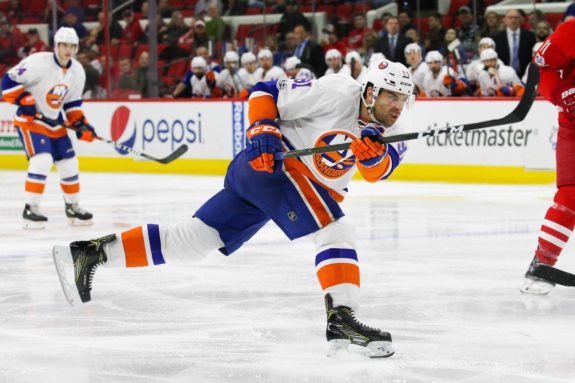
If Tavares doesn’t come to San Jose, the Sharks can play in the more expensive end of the free-agent market. But really, Tavares is the guy San Jose is looking for.
Zeke’s Notes
• Earlier in the article, I alluded to the Sharks’ third-round draft pick. For those unaware of the Sharks’ third-round draft history, let’s just say it’s awful. The Sharks’ third-round draft pick who played the most games for San Jose is 1991 pick Dody Wood. He played 106 games (all in San Jose), had 18 career points and 471 penalty minutes. Thomas Greiss (2004) is easily the best player among third-round picks. He was the Sharks’ backup goalie for four seasons, playing in 44 games. He’s having greater success with his current team, the New York Islanders.
Ville Peltonen (1993) played 59 games in San Jose and is the only other Sharks third-round draft pick to have an NHL career worth mentioning. The remainder of Sharks third rounders combined to play 12 NHL games. The Sharks have a pair of their third-round draft picks still in the organization, though neither looks promising for an NHL career. Mike Robinson, the Sharks’ 2015 pick, is a goalie for the University of New Hampshire, but has played in just two of their 22 games. And 2014 pick Alex Schoenborn is playing in the ECHL for the Allen Americans.
Alas, if San Jose’s third-round picks weren’t cursed enough, the Sharks traded a third-round pick to acquire the infamous Raffi Torres. Between injuries and suspensions, Torres played just 28 games for the Sharks (regular season and playoffs). He totaled six goals and pocketed about $6 million in the process. That’s about $1 million per goal.
• Two of the keys I listed for the Sharks’ second half have gone in opposite directions. The up arrow is strong for Joe Thornton, who has scored goals in four consecutive games. Goalie Martin Jones, however, has a down arrow. Jones has given up nine goals on just 64 shots. When asked about Jones’ health after giving up five goals against Arizona, Sharks head coach Peter DeBoer was openly annoyed with the question. Shortly thereafter, Sharks beat reporter Paul Gackle tweeted (in part): “Martin Jones walked out of #SJSharks locker room with a noticeable limp Thursday. Is he healthy?”
• Speaking of Sharks goaltending, Aaron Dell relieved Jones in the game against Arizona on Jan. 13, a game the Sharks won 6-5 in overtime. It was the first time in Dell’s career the Sharks won a game with him in a relief appearance. The Sharks did not get a point in any of Dell’s relief appearances last season, and they have three points so far this season.